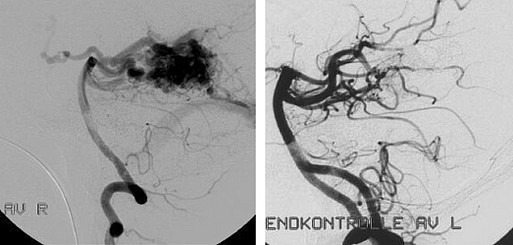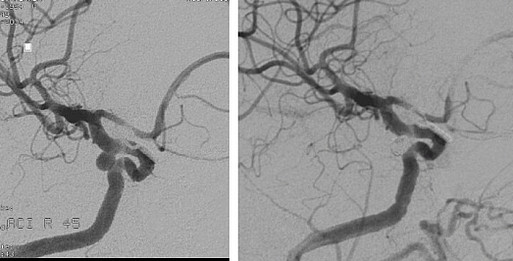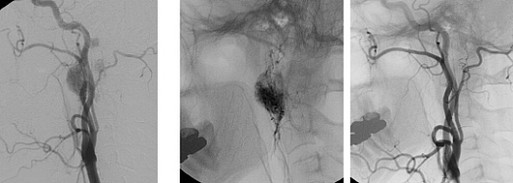Endovascular Occlusions (Embolizations)
Embolizations are used as an emergency procedure in acute bleedings or as planned procedures to occlude pathological vessels in cerebro-vascular malformations like arterio-venous fistulas or angiomas (malformations, AVMs), aneurysms or highly vascularized tumours by glue, particles or platinum coils. The risk of neurological complications due to endocranial embolizations nowadays is below 5%.In case of acute life-threatening nosebleeds or other severe heamorrhages in traumatic or post-operative lesions of the cranial vessels, embolizations are applied as definite or palliative therapy. In these cases, small tubes (catheters) are advanced as closely as possible to the lesion and the leak is occluded by different embolization materials.
In aneurysms, small AVMs and fistulas, embolization with platinum coils and/ tissue adhaesive (“glue”) usually excludes the pathological vessels from the circulation and no further interventions are necessary. In larger AVMs and tumors of the skull base and face however, embolisation mostly is carried out as a palliative intervention to reduce the size of the lesion and the risk of bleeding during subsequent operation or radio- and/or chemotherapy. Because a combination of therapies is usually necessary in these cases, teamwork between the involved neurosurgeons, neuro-oncologists, radiotherapists and ENT- and maxillo-facial surgeons is required and offered as special interdisciplinary approach in Mainz university hospital.
This applies specially to the treatment of endocranial aneurysms. Aneurysms are circumscribed dilatations of the cerebral arteries near the skull base which can rupture and cause a life-threatening intracranial (subarachnoid) bleeding. Aneurysms can have different shapes, but mostly consist out of a sac arising with a neck from the “parent” artery. Until 10 years ago, clipping of the neck by an open neurosurgical approach was the only treatment. Since then, endovascular filling of the neurysm with soft platinum coils pushed through an ultra-thin catheter into the aneurysmal sac has made great progress. This “coiling” is now considered as an alternative therapy specially in small-necked aneurysms because a recent study (ISAT) showed a lower complication rate in case of a more anterior localization of the aneurysm. In broad-necked aneurysms, protrusion of coils into the parent artery can be prevented by a temporary safety balloon in the parent artery or a permanent stent bridging the neck. Other aneurysms, specially those involving the parent artery or those with an arterial outlet from the aneurysmal sac, do better with operation which consists of placing a clip on the neck. Clipping includes the possibility of remodelling the parent artery to some extent if necessary. Thus, the decision between “clipping” and “coiling” is an important issue and a matter of permanent individual case discussion between our endovascular teams of neuroradiologists and neurosurgeons. Postinterventional treatment of subarachnoid heamorrhage as for ventricular dilatation or vasospasm is also offered to our patients as a highly interdisciplinary approach in Mainz.

Arterio-venous angioma (AVM), before (left) and after (right) embolization with ONYX®

Occlusion of carotid aneurysm with 4 platinum coils

Preoperative embolization of highly vascularized glomus tumour at the cranial base